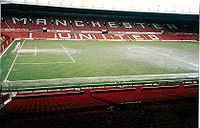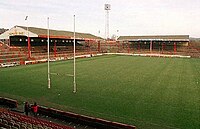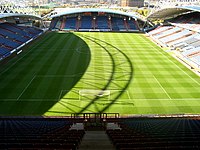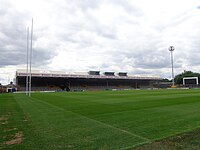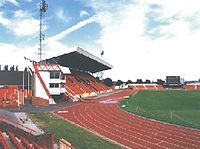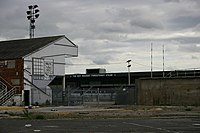The 1989–1992 Rugby League World Cup was the tenth staging of the Rugby League World Cup, and continued to use the three-year format, stretching across the years 1989 to 1992. As with the 1985–1988 World Cup, teams played each other on a home-and-away basis. These matches were fitted into the normal international programme of three-match test series between the nations, with a pre-designated match from each series counting as the World Cup fixture. The tournament culminated in the 1992 Rugby League World Cup final.

Martin Nwokocha Offiah MBE ; born 29 December 1965) is an English former professional rugby league and rugby union footballer who played in the 1980s, 1990s and 2000s. Offiah was inducted into the Rugby League Hall of Fame in 2013. He scored over 500 tries during his rugby league career, making him the third-highest try scorer of all time, and now features in a statue of great rugby league players outside Wembley Stadium.

Bradley Scott Fittler, also known by the nickname of "Freddy", is an Australian rugby league commentator, television presenter, and former player. Fittler is the current head coach of the New South Wales State of Origin team.

Daryl A. Powell is a rugby league coach. He is the former head coach of Warrington Wolves who play in the Super League. He is a former professional rugby league footballer who played as a stand-off in the 1980s, 1990s and 2000s.

Gary Larson is an Australian former rugby league footballer who played as a lock, prop and second-row forward in the 1980s and 1990s.
Timothy Brasher is an Australian former rugby league footballer who primarily played as a fullback in the 1990s and 2000s. He began his career with the Balmain Tigers, where he played the majority of his career. He then moved to the South Sydney Rabbitohs for two seasons, before finishing his career with a season at the North Queensland Cowboys. During his career he also represented New South Wales on 21 occasions and Australia on 16 occasions.
The 1994 Kangaroo Tour was the 18th and last Kangaroo Tour played in the conventional format, where the Australia national rugby league team played a number of matches against British and French clubs or provincial outfits, in additions to the Test matches. The outbreak of the Super League war in early 1995 meant that the next Kangaroo tour, set for 1998, never eventuated; although shortened, test only tours were staged in 2001 and 2003.

Nick Pinkney is an English former professional rugby league footballer who played as a winger and stand-off in the 1980s, 1990s and 2000s. He played at representative level for England, and at club level for Ryedale-York, the Keighley Cougars, the Sheffield Eagles, Halifax, the Salford City Reds and the Hull Kingston Rovers.
Kelvin Skerrett is an English former professional rugby league footballer who played in the 1980s and 1990s, and coached in the 2000s. He played at representative level for Great Britain and Wales, and at club level for Hunslet, Bradford Northern, Western Suburbs Magpies, Wigan and the Halifax Blue Sox, as prop or second-row, and coached at club level for Oulton Raiders ARLFC, and Methley Royals ARLFC.
The 1992–93 Rugby Football League season was the 98th ever season of professional rugby league football in Britain. Sixteen teams competed from August, 1992 until May, 1993 for the Stones Bitter Championship, Premiership Trophy and Silk Cut Challenge Cup.
The 1990–91 Rugby Football League season was the 96th ever season of professional rugby league football in Britain. Fourteen teams competed from August, 1990 until May, 1991 for the Stones Bitter Championship, Premiership Trophy and Silk Cut Challenge Cup.
The 1938–39 Rugby Football League season was the 44th season of rugby league football.
The 1945–46 Rugby Football League season was the 51st season of rugby league football.
The 1973–74 Rugby Football League season was the 79th season of rugby league football.
The 1975–76 Rugby Football League season was the 81st season of rugby league football. The Championship was won by Salford and the Challenge Cup winners were St. Helens who beat Widnes 20-5 in the final. The Rugby League Premiership Trophy winners were also St. Helens who beat Salford 15-2 in the final.
The 1986–87 Rugby Football League season was the 92nd season of rugby league football. Sixteen clubs competed for the Championship which was determined by League position.
The 1995 Trans-Tasman Test series was an international rugby league, three test series played in Australia between the Australian Kangaroos and New Zealand national rugby league team. As the series was played in the middle of the 1995 ARL season and most of the Kiwis selected came from Australian Rugby League (ARL) clubs, New Zealand did not play in any tour matches while in Australia, but prior to the series against Australia they had a two test home series against France.

The 1992 Rugby League World Cup final was the conclusive game of the 1989–1992 Rugby League World Cup tournament and was played between Great Britain and Australia on 24 October 1992 at Wembley Stadium in London, England. Australia won the final by 10 points to 6 in front of an international record crowd of 73,631. Australia, the defending champions, won the Rugby League World Cup for the 7th time.
The 1995 Rugby League World Cup final was the conclusive game of the 1995 Centenary World Cup tournament and was played between England and Australia on 28 October 1995 at the Wembley Stadium in London, England. Australia won the final by 16 points to 8 in front of 66,540 fans. Australia, the defending champions, won the Rugby League World Cup for the 8th time.
The 1972–73 Challenge Cup was the 72nd staging of rugby league's oldest knockout competition, the Challenge Cup.


